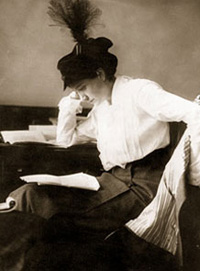Women in Congress: An Introduction
The Historiography of Women in Congress
 Ruth Hanna McCormick of Illinois, daughter of U.S. Senator Marcus Hanna of Ohio and wife of Senator Medill McCormick of Illinois, won election to the House of Representatives in 1928. Congresswoman McCormick drew on her experience as a suffrage lobbyist and National Republican Party official.Image Courtesy of the Library of Congress
Ruth Hanna McCormick of Illinois, daughter of U.S. Senator Marcus Hanna of Ohio and wife of Senator Medill McCormick of Illinois, won election to the House of Representatives in 1928. Congresswoman McCormick drew on her experience as a suffrage lobbyist and National Republican Party official.Image Courtesy of the Library of CongressThe history of this record of women in Congress is three decades old and spans a period of remarkable political achievements by women. The first edition of Women in Congress (H. Con. Res. 664, Report No. 94-1732, 94th Congress, 29 September 1976) was compiled and printed at the time of the U.S. Bicentennial. Proposed by Congresswoman Lindy Boggs, who chaired the Joint Committee on Arrangements for the Commemoration of the Bicentennial, the booklet profiled 95 women who had served in Congress (85 Representatives and 11 Senators; Margaret Chase Smith served in both chambers). The author, Susan J. Tolchin, was then the director of the Washington Institute for Women in Politics at Mount Vernon College. Each Member was profiled in a 200- to 400-word biography, and basic information appeared in a header for each entry. The entries were arranged alphabetically in two sections, one for former Members and the other for current Members. A thumbnail picture accompanied each profile.
Of the Members, the author wrote in a brief introduction, “Few patterns emerged from this group: these women reflected the societies and the era in which they lived; they were a microcosm of prevailing ideologies and political styles.”17 Written against the backdrop of the women’s rights movement and a surge of female participation in local government, the first edition of Women in Congress anticipated a not-too-distant day when women would “move toward equal representation within government.” Tolchin wrote, “Local and state offices act as the seedbed for higher office; we now find many more women running for Congress and the State House as a result of these great strides toward increased representation at lower levels.”18 Though women would play a greater role in government, their ascent through the political ranks no doubt occurred more slowly than Tolchin and many other observers envisioned.
The second edition of Women in Congress (H. Con Res. 167, H. Doc. No. 101-238, 101/2) was authorized by the House and the Senate in 1989. By that point, 129 women had served in Congress—115 Representatives and 16 Senators (Barbara Mikulski and Margaret Chase Smith had served in both chambers). Again, Congresswoman Boggs was an important influence behind the project, introducing the printing resolution as chair of the Commission on the Bicentenary of the U.S. House of Representatives. Of the profiled Members, Boggs wrote, “The story of their lives illustrates an important dimension of the struggle for full participation by all citizens in the political process of our national government. Their congressional service was a prominent legacy of the long campaign for woman’s suffrage and for the acceptance of women in political institutions so long the exclusive domain of men. . . . Although most have supported some form of women’s rights, what unites their careers is not a uniform political stance but rather a common experience with the movement to open political office to women and offer them an equal voice in the federal government.”19
Compiled by the Office of the Historian of the U.S. House of Representatives (which was created in 1983 in preparation for the House Bicentennial), the second edition of Women in Congress had a format similar to that of the first edition. Published for the first time as a hardbound book, the volume contained Member profiles that were slightly longer than those in the first edition (250 to 700 words), with basic biographical information incorporated into the narrative. In this edition, the profiles of former and current Members were merged into one section, which again was arranged alphabetically. Larger pictures accompanied the individual profiles.
Footnotes
- Susan Tolchin, Women in Congress, 1917–1976 (Washington, D.C.: Government Printing Office, 1976): iii.
- Tolchin, Women in Congress, 1917–1976: iii.
- Office of the Historian, U.S. House of Representatives, Women in Congress, 1917–1990 (Washington, D.C.: Government Printing Office, 1991): v.
